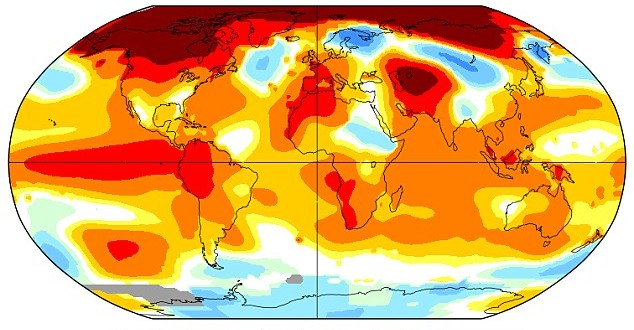El Niño is continuing to break records after pushing the global average temperature last month to its highest ever level for January.
Not only was January the hottest ever, the new temperature was the biggest increase over the previous record in more than a century of records, according to figures released by NASA. NASA’s climate records go back to 1880.
The global average temperature at Earth’s surface for January 2016 was 1.13 degrees C above the 1951-1980 average (the benchmark NASA uses to measure warming trends). That’s a full 2 degrees F warmer than pre-1980 levels. The previous record for January, set in 2007, was .95 C, or 1.71 degrees F above average.
January also chalked up the hottest anomaly — or departure from the long-term norm — for any month on record.
January 2016’s global land and sea-surface temperatures were 0.52 degrees above the average for 1981-2010, reported Japan’s Meteorological Agency. That departure from the norm easily eclipsed the previous record of 0.29 degrees in 2002, 2007 and 2015.
January NASA data: hottest January, biggest increase over previous record and hottest anomaly for any month ever. pic.twitter.com/W517iYwuja
— Prof. Stefan Rahmstorf 🌏 🦣 (@rahmstorf) February 15, 2016
“The record is helped along a bit by El Nino, but most of it — more than 80% — is due to human-caused global warming,” said Stefan Rahmstorf, a professor of physics at Potsdam University. “A strong El Nino event can elevate the monthly global temperature by up to 0.2 degrees, but this January is a whopping 1.1 degrees warmer than the average January during the baseline period of 1951-1980.”
During El Nino years, the usual westward-blowing trade winds stall or reverse, lowering the rate the ocean absorbs the excess heat being trapped in the atmosphere by rising levels of greenhouse gases. Annual global temperature records were shattered in 2014 and then again in 2015, with 2016 off to a very hot start.
“This sequence of new records every few years — and now even two in a row — reflects the on-going rapid global warming trend,” said Rahmstorf. Southern Europe, Saharan Africa and northwestern South America racked up some scorcher temperatures over the record month.
But extreme warmth in the high latitudes of the Northern Hemisphere played a key role in driving global temperatures up in January 2016, notes Discover magazine. Over the long run, warming in the Arctic has occurred about twice as fast as the rest of the globe.
“For the Arctic this is definitely the strangest winter I’ve ever seen,” Mark Serreze, the director of the National Snow and Ice Data Center, told Mashable. The entire Arctic was “just absurdly warm.”
Agencies/Canadajournal
 Canada Journal – News of the World Articles and videos to bring you the biggest Canadian news stories from across the country every day
Canada Journal – News of the World Articles and videos to bring you the biggest Canadian news stories from across the country every day



